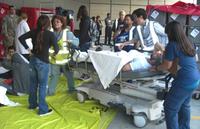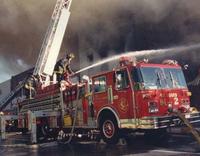-
Philadelphia police hold emergency exercise
On Wednesday morning the Philadelphia police department held a training exercise to help prepare officers to respond during a terrorist attack; starting at 10:30 AM roughly 50 officers gathered on 22nd Street and JFK Boulevard where they were given assignments, briefed, and eventually deployed to cover different sections of Center City; The drill involved members of the department’s Homeland Security Unit and was a rapid deployment exercise that reflected Philadelphia’s heightened level of awareness following the death of Osama bin Laden
-
-
Improving safety in the presence of chemical hazards
A new kind of sensor could warn emergency workers when carbon filters in the respirators they wear to avoid inhaling toxic fumes have become dangerously saturated; first responders protect themselves from such vapors, whose composition is often unknown, by breathing through a canister filled with activated charcoal — a gas mask; airborne toxins stick to the carbon in the filter, trapping the dangerous materials, and as the filters become saturated, chemicals will begin to pass through; the respirator can then do more harm than good by providing an illusion of safety
-
-
DHS IG criticizes FEMA's IT systems
DHS Inspector General says that FEMA’s IT systems “do not support disaster response activities effectively”; the IG recommends that FEMA develop a comprehensive IT strategic plan with clearly defines goals and objectives to support program IT initiatives, and that FEMA establish an agency-wide IT budget planning process to include all FEMA program technology initiatives and requirements
-
-
Missouri pounded by rains and tornadoes, thousands evacuate
This week heavy rain storms are raging across the mid-west and south forcing thousands of residents in Missouri to flee as swollen rivers threaten to flood their homes; in some areas emergency responders do not have many options and can do nothing but hope that the levees hold; the mid-west will not see any respite from the storms until Thursday as another major storm system is about to hit; officials are bracing for substantial flooding; the region is still struggling to recover from major storms that spawned tornadoes in six states killing forty-five people and damaging structures; Missouri has requested aid from the Federal Emergency Management Agency
-
-
Japanese app helps spread earthquake warning
After the 9.0 magnitude earthquake and tsunami ravaged Japan, hundreds of thousands of people have signed up for a new emergency warning app for their iPhones; when an earthquake is predicted to hit, the iPhone app, called Yure Kuru, will send out an alert and let subscribers know when the quake is coming, where the epicenter is located, and how bad the shaking will be; the app was developed by Tokyo based RC Solution Co., which specializes in mass alert systems and spreading information in the event of an emergency; since the 11 March earthquake, the company’s subscribers have sky rocketed from 100,000 to more than 1.5 million
-
-
AT&T shows mobile cell towers for disaster communication

A new family of solutions from AT&T will make business, government, and public safety agencies better prepared for natural or man-made disasters; one of the new offerings, the “Fly-away” solution, packs a small cell site into a suitcase, offering first responders an easy-to-use, transportable system that can bring voice and data coverage to an area where disaster has knocked out communication channels
-
-
NY emergency services communication not up to snuff
Nearly ten years after the 9/11 attacks, many police officers and first responders in New York still carry radios that cannot communicate with fellow emergency services personnel working for other agencies and jurisdictions; often, they use their personal cell phones during an operation; state lawmakers want this situation changed
-
-
New cloth captures noxious gasses, odors
Cornell university students develop a new cloth that can capture noxious gasses and odors — and that can be fashioned into masks or hooded shirts to be used by soldiers and first responders; the garments use metal organic framework molecules (MOFs) and cellulose fibers
-
-
Disaster-zone phone communication software available for free
Australian researchers developed software which enables mobile phones to communicate during a disaster; it will be freely available to the public by the end of the year thanks to the support of the Dutch NLnet Foundation; the software can be used on compatible mobile phone handsets to create an alternative “network” where conventional mobile phone coverage has been destroyed or does not exist
-
-
Report finds Coast Guard unprepared for BP oil spill
An internal review by the U.S. Coast Guard found that its response to the colossal Deep Water Horizon oil spill in the Gulf of Mexico last year was hindered by its lack of preparation and reduced response capabilities; the 158 page review said that the government and private sector “demonstrated a serious deficiency in planning and preparedness for an uncontrolled release of oil from an offshore drilling operation”; in response to the review, R. J. Rapp Jr., the commandant of the Coast guard, said that his agency would pay greater attention to industry oil-spill response plans, begin preparing for future accidents, and conduct a study on the large use of chemical dispersants on the environment
-
-
DHS: U.S. unprepared for nuclear disaster

Confidential DHS report says the United States is ill-prepared for a nuclear disaster — either an accident or a terrorist attack; just one example: if a major nuclear bomb were to hit Washington, D.C., there would be a need for about 61,000 beds in intensive care units; there are, however, only 118,000 intensive care beds in the entire United States and, on any given day, only 9,400 are free.
-
-
New Zealand company to offer personal jet packs
A New Zealand company has successfully tested a jet pack, and will soon make it commercially available for about £50,000; in tests, the pack, which weighs less than 254 pounds, traveled 30 miles in 30 minutes on a full tank of fuel; it reached heights of up to 2,400 meters and top speeds of 60 mph; the company said the pack could be perfect for the emergency services, private users, and even the military
-
-
Portable military barriers help Canadian city in flood fight
Canada is using a new technology to prevent flood damage in Manitoba; the one-meter-square wire cages can be unfolded and quickly filled with dirt or mud; they can also be linked for a long row that can be set up far quicker than it takes to sling sandbags; the barriers have been used by the U.S. military to protect embassies from terrorist attacks, and have also been used for flood protection in the United States
-
-
DHS grant buys upgrades for MS police department's bomb squad
The local police department of Tupelo, Mississippi is spending $50,000 to bolster its bomb squad’s capabilities thanks to a grant from DHS; the grant was awarded to Tupelo’s Explosive Ordinance Disposal Team and will be used to buy new equipment as well as a bomb disposal robot; So far Tupelo’s bomb squad has responded to three calls regarding suspicious packages, which all turned out to be false alarms; Tupelo’s bomb squad will also benefit other local police departments in the area and police chiefs are grateful
-
-
DHS grant saves St. Louis firefighters' jobs

Thirty St. Louis, Missouri firefighters caught a break last week after the city received a $3.2 million grant from DHS; the city had planned on cutting their jobs, but the DHS grant will allow the firefighters to stay employed;the money comes as part of the Staffing for Adequate Fire and Emergency Response (SAFER) program which is aimed at helping local fire departments maintain adequate staffing levels; Federal Emergency Management Agency (FEMA) administers the grant and plans to allocate $420 million this year to fire departments across the country that have been hit by budget cuts
-
- All
- Regional
- Water
- Biometrics
- Borders/Immig
- Business
- Cybersecurity
- Detection
- Disasters
- Government
- Infrastructure
- International
- Public health
- Public Safety
- Communication interoperabillity
- Emergency services
- Emergency medical services
- Fire
- First response
- IEDs
- Law Enforcement
- Law Enforcement Technology
- Military technology
- Nonlethal weapons
- Nuclear weapons
- Personal protection equipment
- Police
- Notification /alert systems
- Situational awareness
- Weapons systems
- Sci-Tech
- Sector Reports
- Surveillance
- Transportation
Advertising & Marketing: advertise@newswirepubs.com
Editorial: editor@newswirepubs.com
General: info@newswirepubs.com
2010-2011 © News Wire Publications, LLC News Wire Publications, LLC
220 Old Country Road | Suite 200 | Mineola | New York | 11501
Permissions and Policies
Editorial: editor@newswirepubs.com
General: info@newswirepubs.com
2010-2011 © News Wire Publications, LLC News Wire Publications, LLC
220 Old Country Road | Suite 200 | Mineola | New York | 11501
Permissions and Policies
